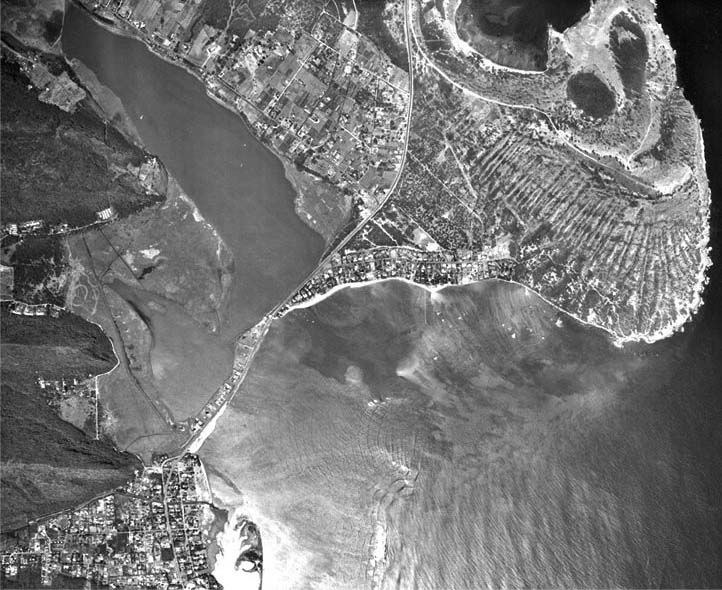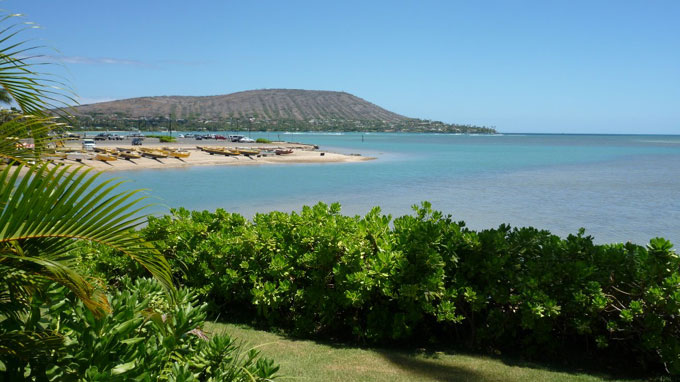Waikīkī (“water spurting from many sources”) ahupuaʻa lies between Honolulu (from the west side of Makiki Valley) and Maunalua (the east side of Wailupe) – essentially from Piʻikoi Street to the ʻĀina Haina/Niu Valley boundary.
It included several ʻili, subdivisions/portions of ahupuaʻa. Wailupe is one of these ʻili; it is actually an ʻili lele (jumping ʻili) that includes the area we now call ʻĀina Haina and kalo (taro loʻi) lands in nearby Pālolo Valley.
From ancient times, we learn Wailupe is part of the tradition of Kamapuaʻa, a multi-formed deity.
The Hawaiian deity Kamapuaʻa, is a part of the Lono god-force, and possessed many body forms (kinolau), representing both human and various facets of nature. He was born in pig-form to Hina (mother) and Kahiki‘ula (father) at Kaluanui in the Koʻolauloa District of O‘ahu. (Maly)
ʻOlopana, an Oʻahu Chief (and younger brother of Kahiki’ula,) was an adversary of Kamapuaʻa. After several skirmishes and confrontations between them, Kamapuaʻa finally killed ʻOlopana and conquered Oʻahu.
When Kamapuaʻa started to divide the land, one of the notable aspects of the tradition of Kamapuaʻa is that, Lonoawohi, his priest, asked for and received the lands whose names begin with the word “wai” (i.e. Waikiki, Waianae, Waiawa … and Wailupe. Thus, the priests of the Lono class received the “wai” lands. (Maly)
In Hawai‘i and essentially in all cultures – water meant life and growth. In Hawai‘i – “Wai” – fresh water – is a life force – it meant abundance and wealth and was a consistent theme in native traditions, practices, land use and historical accounts.
Wailupe (literally, “kite water”) suggests this was one of the prescribed places to fly kites, some suggesting the land was named “for a kite-flying woman (he wāhine hoʻolele lupe.)”
Another name for the area was Kekaha (“the place”) and is noted in the names of the winds the canoes could expect while sailing along the southeast coast of Oʻahu:
Puuokona is of Kuliʻouʻou
Ma-ua is the wind of Niu
Holouhā is of Kekaha (Wailupe)
Māunuunu is of Wai‘alae
The wind of Lēʻahi turns here and there …
There are three gulches forming the valley; the main Wailupe Gulch follows the lower Wailupe Stream and a branch to the northwest. The northeast branch follows Laulaupoe Gulch, which is named for a round (poe) type of leaf package (laulau) used for food and for presentations.
Above, there is a third gulch called Kuluʻī, which is named for a type of tree/shrub. On early maps, a second small stream is shown on the western side called Waialiʻi (probably “water of the chiefs.”) (Cultural Surveys)
What we know today as Wailupe Peninsula is the former Wailupe Fishpond. The Hawaiian term for the pond was Loko Nui o Wailupe, “big pond of Wailupe.”
Just mauka of the fishpond (makai of the main coastal trail, now covered by Kalanianaʻole Highway) was a spring called Puhikani. There was a second spring, which fed a fishpond of the same name, on the west side of Wailupe Pond called Punakou, which means “kou tree spring.”
Kawaikuʻi Beach Park is named after a freshwater spring in this area that was the only source of drinking water for the coastal residents. Kawaikuʻi means “the united water” (named either because of the salt and fresh water “united” at the spring or because Wailupe residents once came to wash their clothes on flat rocks near the spring and to gather limu – thus the population congregated or “united” at this spot.)
In 1826, the missionary Levi Chamberlain took a tour of the island of O‘ahu, traveling through the southern coast of O‘ahu westward from Makapuʻu. He recorded a settlement of eighteen houses at Maunalua, with three additional settlements between Maunalua and Wai‘alae. These settlements were probably at Kuliʻouʻou, Niu and Wailupe. At Wai‘alae he stopped at a settlement with a schoolhouse. (Cultural Surveys)
The land of Wailupe was reportedly distributed to the father of Kamaha by Kamehameha the Great following the Battle of Nuʻuanu in 1795.
At the Māhele, Kamaha, konohiki (land manager) of the land, received Wailupe, retaining half and returning half. (The King accepted “the large Fish pond (Wailupe Pond) and one acre of Kula land in the Ili of ‘Wailupe’ Oʻahu;” Kamaha received the remainder of the land and all of the smaller fishponds.) (Cultural Surveys)
In Wailupe, 57 claims were made and 37 were awarded, indicating that there was substantial settlement in the area. The claims were mainly for kula lands with sweet potato, coconut, orange, hala, ipu and pili grass with no mention of taro being grown. Lots averaged 1.5-acres with two kula patches. The majority of lots were adjacent to major streams within the valley.
In 1924, Robert Hind purchased 2,090-acres and established the Hind-Clarke Dairy. The Hind-Clarke Dairy was a favored stop along the road, as noted in a 1930 visitor’s guide: “The Hind-Clarke Dairy, a short way ahead and to our left with a large sign over the entrance, is not to be passed unnoticed. The dairy is a model of its kind and well affords an opportunity to see dairying in its most scientific form. The cottage cheese on sale is, perhaps, the most delicious you have ever tasted.” (Cultural Surveys)
In 1946, Hind sold his dairy operation to Creameries of America, and soon after that began to develop the remainder of his land for residential use. The former cattle pasture was subdivided into lots to form a new residential community called ‘Āina Haina (which means, “Hind’s land.”)
Soon after this the Hawaiian Dredging Company filled in the old Wailupe Fishpond, forming the Wailupe Circle subdivision. A deep channel (depth of approximately 12 to 20 feet) was dredged around the pond, as well as a channel through the reef to the open ocean) and dredge material filled in the pond.
The ‘Āina Haina Shopping Center was built in 1950 (Hawaiʻi’s first McDonald’s opened there on November 2, 1968.) (The Hind Clark Dairy operation occupied the area now used as ʻĀina Haina Shopping Center and ʻĀina Haina Elementary School.) (Lots of information here from Maly and Cultural Surveys)






















































